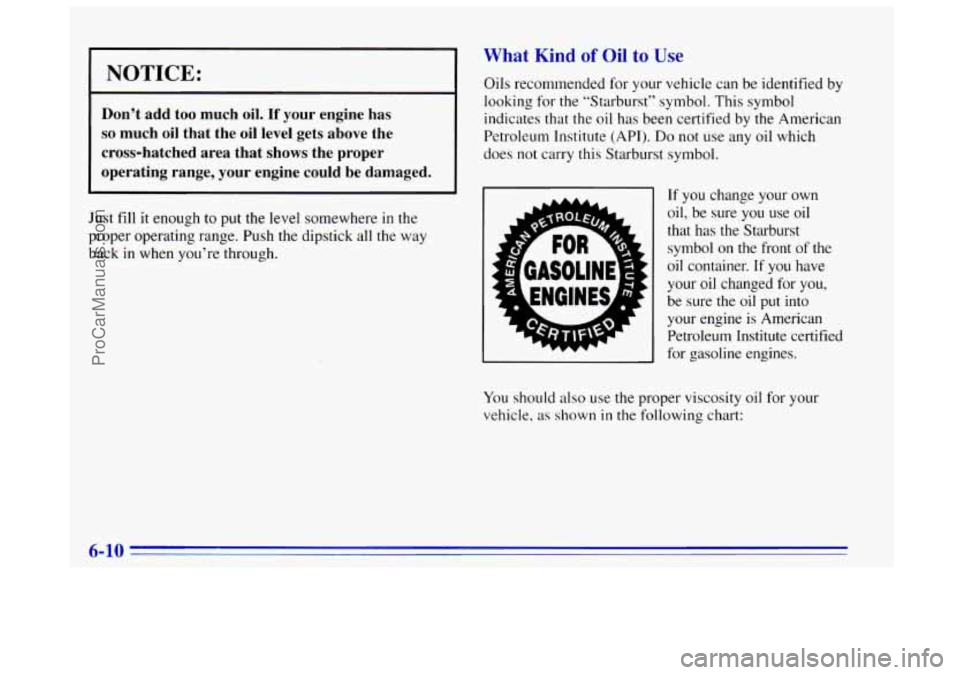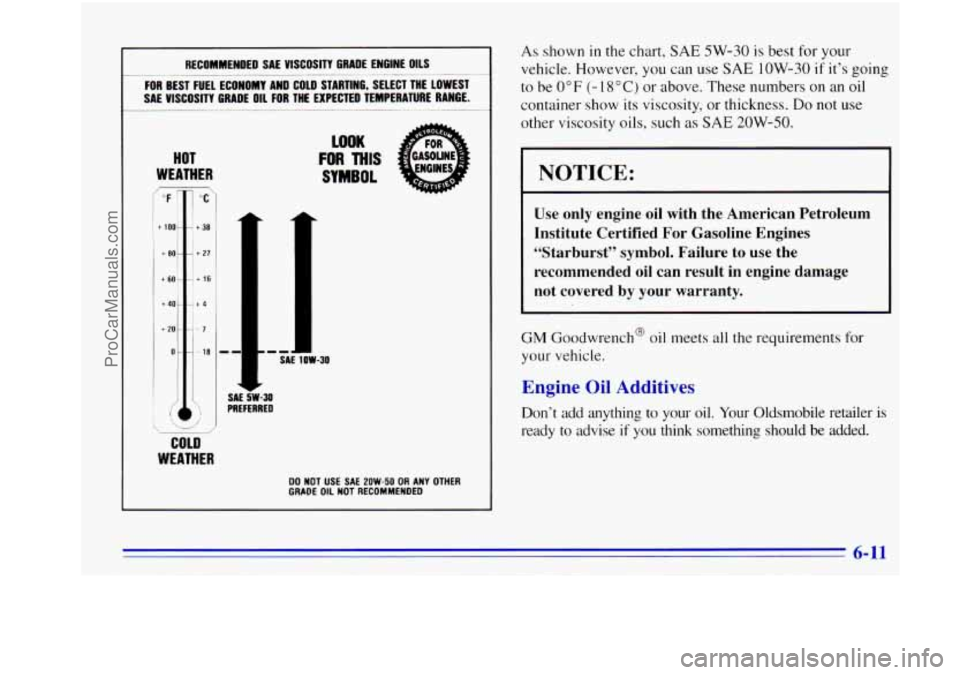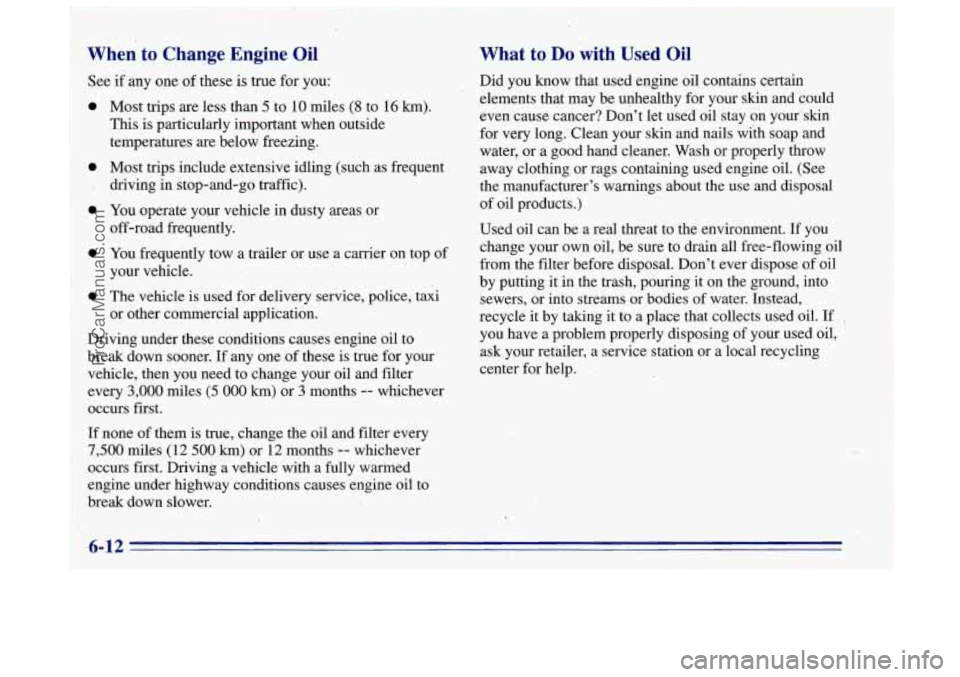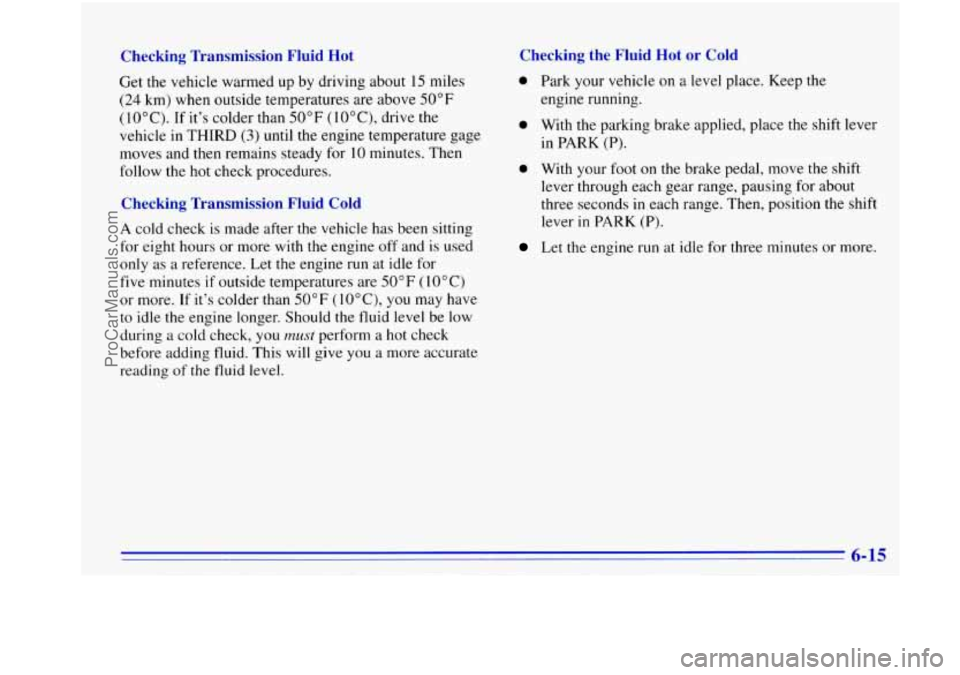OLDSMOBILE BRAVADA 1996 Owners Manual
Manufacturer: OLDSMOBILE, Model Year: 1996, Model line: BRAVADA, Model: OLDSMOBILE BRAVADA 1996Pages: 340, PDF Size: 17.49 MB
Page 221 of 340

Before closing the hood, be sure all the filler caps are on
properly. Then lift the hood to relieve pressure on the
hood prop.
Remove the hood prop from the slot in the hood and
return the prop to its retainer.
Then just pull the hood down firmly to close. It will latch when dropped from
10 to 12 inches (25 to 30 cm)
without pressing on the hood.
Engine Oil.
It’s a good idea to check your engine oil every time you
get fuel. In order to get an accurate reading, the oil must
be warm and the
vehicle must be on level ground.
The oil dipstick is a
yellow ring.
Turn off the engine and
give the oil a few minutes
to drain back into the oil
pan.
If you don’t, the oil
dipstick might not show
the actual level.
-
Checking Engine Oil
Pull out the dipstick and clean it with a paper towel or
cloth, then push it back in all the way. Remove it again,
keeping the tip down, and check the level.
When to Add Oil
If the oil is at or below the ADD line, then you’ll need
to add some oil. But you must use the right kind. This
part explains what kind
of oil to use. For crankcase
capacity, see “Capacities and Specifications” in
the Index.
6-9
ProCarManuals.com
Page 222 of 340

NOTICE:
Don’t add too much oil. If your engine has
so much oil that the oil level gets above the
cross-hatched area that shows the proper
operating range, your engine could be damaged.
Just fill it enough to put the level somewhere in the
proper operating range. Push the dipstick all
the way
back in when you’re through.
What Kind of Oil to Use
Oils recommended for your vehicle can be identified by
looking for the “Starburst” symbol. This symbol
indicates that the oil has been certified by the American
Petroleum Institute (API).
Do not use any oil which
does not carry this Starburst symbol.
You should also use the proper viscosity oil for your
vehicle, as
shown in the following chart:
If you change your own
oil, be sure you
use oil
that has the Starburst
symbol on the front of the
oil container.
If you have
your
oil changed for you,
be sure the oil put into
your engine is American
Petroleum Institute certified
for gasoline engines.
ProCarManuals.com
Page 223 of 340

RECOMMENDED SAE VISCOSITY GRADE ENGINE OILS
FOR BEST FUEL ECONOMY AND COLD STARTING, SELECT THE LOWEST
SAL VISCOSITY GRADE OIL
FOR THE EXPECTED TEMPERATURE RANGE.
-__- ...... ~ __
HOT
WEATHER
COLD
WEATHER
LOOK
FOR THIS
SYMBOL
SAE CW-30 PREFERRED
DO NOT USE SAE 2OW-50 OR ANY OTHER
GRAOE OIL NOT RECOMMENDED
As shown in the chart, SAE 5W-30 is best for your
vehicle. However, you can use
SAE low-30 if it’s going
to be
0” F (- 1 8 O C) or above. These numbers on an oil
container show its viscosity, or thickness. Do not use
other viscosity oils, such as
SAE 20W-50.
I NOTICE:
Use only engine oil with the American Petroleum
Institute Certified For Gasoline Engines
“Starburst” symbol. Failure to use the
recommended oil can result in engine damage
not covered by your warranty.
GM Goodwrench@ oil meets all the requirements for
your vehicle.
Engine Oil Additives
Don’t add anything to your oil. Your Oldsmobile retailer is
ready to advise
if you think something should be added.
ProCarManuals.com
Page 224 of 340

When to Change Engine Oil
See if any one of these is true for you:
0
0
0
Most trips are less than 5 to 10 'miles (8 to 16 km).
This is particularly important when outside
temperatures.are below freezing.
Most trips include extensive idling (such as frequent
driving in stop-and-go traffic).
You operate your vehicle
in dusty areas or
off-road frequently.
You frequently tow
a trailer or use a carrier on top of
your vehicle.
The vehicle
is used for delivery service, police, taxi
or other commercial application.
~~ ,. -: . 1 Driving under these conditions causes engine oil to
down sooner.
If any one of these is true for your
then you need to change your oil and filter
miles
(5 000 km) or 3 months -- whichever
ccurs first.
f none of them is true, change the oil and filter every
ccurs first. Driving a vehicle with
a fully warmed
., (12 500 lun) or 12 months -- whichever
highway conditions causes engine oil to
. . . -, I break down slower. '.
. -. . .. .. : .. ._ . . .., ,
What to Do with Used Oil
Did you know that used engine oil contains certain
elements that may be unhealthy for your skin and could
even cause cancer? Don't let used oil stay on your skin
for very long. Clean your skin and nails with soap and
water, or a good hand cleaner. Wash or properly throw
away clothing or rags containing used engine oil. (See
the manufacturer's warnings about the use and disposal
of oil products.)
Used oil can be a real threat to the environment.
If you
change your own oil, be sure to drain all free-flowing oil
from the filter before disposal. Don't ever dispose of oil
by putting it in the trash, pouring it on the ground, into
sewers, or into streams or bodies
of water. Instead,
recycle it by taking it to a place that collects used oil.
If ,
you have a problem properly disposing of your used oil, '
ask your retailer, a service station or a local recycling
center for help.
ProCarManuals.com
Page 225 of 340

4ir Cleaner
To remove the air cleaner,
open both clamps and push
the rear of the air cleaner
toward the rear
of the
engine compartment.
Insert
a new filter. Then replace the air cleaner
assembly, making certain the
PVC air tube is properly
seated
in the left hand valve cover and the clamps are
securely fastened.
Refer to the Maintenance Schedule
to determine when to
replace the air filter.
See “Scheduled Maintenance Services”
in the Index.
I
Operating the engine with the air cleaner off
can cause you
or others to be burned. The air
cleaner not only cleans the air, it stops flame if
the engine backfires.
If it isn’t there, and the
engine backfires, you could be burned. Don’t
drive with it off, and be careful working on the
engine with the air cleaner off.
I NOTICE:
If the air cleaner is off, a backfire can cause a
damaging engine fire. And, dirt can easily get
into your engine, which will damage it. Always
have the air cleaner in place when you’re driving.
6-13
-
ProCarManuals.com
Page 226 of 340

Automatic Transmission Fluid
When to Check and Change
A good time to check your automatic transmission fluid
level is when the engine oil is changed.
Change both the fluid and filter every
50,000 miles
(83 000 km) if the vehicle is mainly driven under one or
more
of these conditions:
In heavy city traffic where the outside temperature
regularly reaches
90°F (32°C) or higher.
In hilly or mountainous terrain.
0 When doing frequent trailer towing.
Uses such as found in taxi, police or delivery service.
If you do not use your vehicle under any of these
conditions,
the fluid and filter do not require changing.
See “Scheduled Maintenance Services” in the Index.
How to Check
Because this operation can be a little difficult, you may
choose to have this done at your Oldsmobile retail
facility Service Department.
If you do it yourself, be sure to follow all the instructions
here, or you could get a false reading on the dipstick.
I NOTICE:
- ~~
Too much or too little fluid can damage your
transmission.
Too much can mean that some of
the fluid could come out and fall on hot engine
parts
or exhaust system parts, starting a fire. Be
sure to get an accurate reading if you check your
transmission fluid.
Wait at least 30 minutes before checking the
transmission fluid level
if you have been driving:
0 When outside temperatures are above 90°F (32°C).
0 At high speed for quite a while.
0 In heavy traffic -- especially in hot weather.
0 While pulling a trailer.
To get the right reading, the fluid should be at normal
operating temperature, which
is 180°F to 200°F
(82°C to
93°C).
ProCarManuals.com
Page 227 of 340

Checking Transmission Fluid Hot
Get the vehicle warmed up by driving about 15 miles
(24 km) when outside temperatures are above 50°F
(10°C). If it's colder than 50°F (lO"C), drive the
vehicle in THIRD
(3) until the engine temperature gage
moves and then remains steady for
10 minutes. Then
follow the hot check procedures.
Checking Transmission Fluid Cold
A cold check is made after the vehicle has been sitting
for eight hours or more with the engine off and
is used
only
as a reference. Let the engine run at idle for
five minutes
if outside temperatures are 50°F (10°C)
or more. If it's colder than 50°F (lO"C), you may have
to idle the engine longer. Should the fluid level be low
during a cold check, you must perform a hot check
before adding fluid. This will give
you a more accurate
reading of
the fluid level.
Checking the Fluid Hot or Cold
0 Park your vehicle on a level place. Keep the
engine running.
0 With the parking brake applied, place the shift lever
in PARK
(P).
0 With your foot on the brake pedal, move the shift
lever through each gear range, pausing for about
three seconds
in each range. Then, position the shift
lever
in PARK (P).
Let the engine run at idle for three minutes or more.
ProCarManuals.com
Page 228 of 340

Then, without shutting off the engine, follow these steps:
1. Flip the handle up and then pull out the dipstick and
wipe it with
a clean rag or paper towel.
2. Push it back in all the way, wait three seconds and
then pull it back out again.
3. Check both sides of the dipstick, and read the lower
level. The fluid level must be
in the COLD area for a
cold check or in the HOT area or cross-hatched area
for a hot check.
4. If the fluid level is in the acceptable range, push the
dipstick back in all the
way; then flip the handle
down to lock the dipstick in place.
ProCarManuals.com
Page 229 of 340

How to Add Fluid All-Wheel Drive
Refer to the Maintenance Schedule to determine what
kind
of transmission fluid to use. See “Recommended
Fluids and Lubricants”
in the Index.
Add fluid only after checking the transmission fluid
HOT. (A COLD check is used only as a reference.) If
the fluid level is low, add only enough of the proper
fluid
to bring the level up to the HOT area for a hot
check.
It doesn’t take much fluid, generally less than a
pint
(0.5 L). Don’t overfill. We recommend you use only
fluid labeled DEXRON@-111, because fluid with that
label is made especially for your automatic transmission.
Damage caused by fluid other than DEXRON-I11 is not
covered by your new vehicle warranty.
Transfer Case
When to Check Lubricant
Refer to the Maintenance Schedule to determine how
often
to check the lubricant. See “Periodic Maintenance
Inspections“
in the Index.
How to Check Lubricant
After adding fluid, recheck the fluid level as
described under
“How to Check.”
When the correct fluid level is obtained, push the
dipstick back in all the way; then flip the handle
down
to lock the dipstick in place.
If the level is below the bottom of the filler plug hole,
you’ll need
to add some lubricant. Add enough lubricant
to raise the level to the bottom of the filler plug hole.
6-17
.~ --
ProCarManuals.com
Page 230 of 340

What to Use
Refer to the Maintenance Schedule to determine what
kind of lubricant to use. See “Recommended Fluids and
Lubricants”
in the Index.
Front Axle
When to Check and Change Lubricant
Refer to the Maintenance Schedule to determine how
often to check the lubricant and when to change
it. See
“Scheduled Maintenance Services”
in the Index.
How to Check Lubricant
n
If the level is below the bottom of the filler plug hole,
you’ll need to add some lubricant. Add enough lubricant
to raise the level to the bottom
of the filler plug hole.
What to Use
Refer to the Maintenance Schedule to determine what
kind
of lubricant to use. See “Recommended Fluids and
Lubricants”
in the Index.
6-18
ProCarManuals.com